A rhinoceros desk, Marie Antoinette’s pink diamond (maybe?) and a bed made of glass
And some other random stuff.
I need to bring something to everyone’s attention:
Behold: Grand Rhinocrétaire II. This absolute unit is a nearly life-size bronze rhino that, yes, conceals a desk. He is number one of an edition of eight desks created by French artist François-Xavier Lalanne (of the famous husband-and-wife artist duo known as “Les Lalanne”) in 2003, and he’s made of gold patinated bronze, brass and leather.
Les Lalanne enjoyed a long career designing sculpture, furniture and jewelry with a whimsical and sometimes surreal vision that was often inspired by nature. They were initially exhibited alongside Surrealist artists in the 1960s, but they’ve sometimes been considered less intellectually rigorous, which I suppose means their work is too pretty or too fun. I think this quote in the Art Newspaper by one of their former dealers sums up their work perfectly:
“[They were informed by the] Surrealist idea of the radical juxtaposition, the opposite of form follows function. It’s having something that looks like a rhinoceros but then unfolds and becomes all of these other amazing things in a bar. You get this sort of cognitive dissonance but also joy when you start to experience them.”
Yes, more joy please.
Grand Rhinocrétaire II was not Lalanne’s first rhino desk. That one — Rhinocrétaire I — debuted in 1964, and it was literally his first sculptural work undertaken after he’d decided to quit painting. It remains his most iconic. Like the piece above, Rhinocrétaire I also concealed a desk — as well as a safe, a bar and wine storage, AND it had built-in electric desk lamps. It lived in the collection of one family from 1964 to 2023, when it was sold in a single-lot auction at Christie’s Paris for a record-breaking €18.3 million. (Click on that link above for a series of images and a cool but potentially seizure-inducing video.)
Grand Rhinocrétaire II stomped on its hefty estimate of $3-5 million and sold for $16.4 million in last Wednesday’s Important Design live auction at Sotheby’s New York. Hopefully whoever bought him also picked up this circa 1902 Carlo Bugatti Throne Chair.
While I have you here looking at non-jewelry-related whimsy, be sure to scroll through the Maurice Sendak auctions that happened last week at Christie’s New York. The Maurice Sendak: Artist, Collector, Connoisseur Online auction closed on Thursday, and the live auction was held the day before. It included — alongside his own original artwork — an extraordinary collection of prints and drawings by artists including Goya, Blake, Stubbs, Fuseli, Toulouse-Lautrec, Cezanne and Picasso.
It also included “A Snail guarding their Nest,” the ridiculously charming Beatrix Potter watercolor above. Signed and dated 1898, it depicts a snail warding off some woodlice1 with a tiny spade. The piece was estimated at $12,000 – $18,000 and sold for $40,000 because it’s awesome.
But back to the online auction. This one’s fun — there are a lot of prints in this sale, too, but also some Disney animation sketches, a drawing of Sendak’s beloved dog Jennie, and a Bugs Bunny that Chuck Jones drew on a napkin.
Both sales were in support of the Sendak Fellowship at the Maurice Sendak Foundation, “a residency programme that encourages, teaches and supports artists who tell stories with illustration.” Lord knows they need whatever they can get now that Sam Altman has stolen and churned all their work into a giant blender of AI slop.
The Sotheby’s “High Jewelry”2 auction in New York was on Friday, and it included the usual big silly diamonds, like this 35.01 carat Graff ice cube. I seem to be going with a more whimsical theme today, though, so I’ll point out one of my favorite pieces of jewelry: the “La Méduse” clip-brooch created by French designer Jean Schlumberger for Tiffany & Co.
Schlumberger started his design career making brooches for Parisian flea markets and buttons for Elsa Schiaparelli, but it wasn’t until after his service in the French Army and Free French Forces in World War II that he embraced jewelry full-time. He and his business partner, Nicolas Bongard, opened a jewelry store in New York City in 1946, followed by a Paris location in 1950.
In 1956 the pair was asked to join Tiffany & Co. After decades of design prowess, the famous company was struggling, so the newly installed Tiffany chairman and force of nature Walter Hoving enlisted a group of artists, including Schlumberger, Elsa Peretti and window designer Gene Moore to shake things up. (If you’re one of my long-timers, you may remember I waxed poetic about the endlessly creative Gene Moore back in 2020.)
Schlumberger’s designs for Tiffany went on to become some of the company’s most iconic pieces, particularly his “Bird on a Rock” brooch. That design, and the one above, showcase his love of nature and tendency toward whimsy. He was particularly enamored with sea life, and his “La Méduse” brooch depicts a stylized jellyfish with a domed mantle of moonstones and diamonds, swirling arms of sapphire and articulated tentacles of gold that move with the wearer.
The piece sold just over its $60,000 - $90,000 estimate for $95,250.
The 10.38 carat diamond above dates to the mid-18th century and is known as the “Marie-Thérèse Pink.” We know from extensive documentation that it belonged to Queen Marie Antoinette’s daughter, Duchess Marie-Thérèse d’Angoulême, but there’s considerable speculation that it first belonged to the Queen herself and was included in the stash of precious jewelry she entrusted to her hairdresser prior to her failed escape attempt from Paris in 1791.
Following Marie Antoinette’s death and the fall of the monarchy, that stash of jewels was given to Marie-Thérèse, her only surviving child. The history of the stone — involving a tiara and a hairpin and multiple diamonds — is recounted in detail in the lot essay, but the short version is that it was passed down twice more, landing in the collection of Queen Maria Theresa of Bavaria. It then remained in that royal family for generations until 1996, when they sold it at Sotheby’s Geneva.
It’s now available again, this time cradled in a diamond-studded blackened platinum fleur-de-lis ring setting by none other than the famous and reclusive jewelry designer Joel Arthur Rosenthal — a.k.a. JAR, who you’re probably sick of reading about in this newsletter. Sorry.
Even without the royal pedigree and JAR setting, the stone itself is lovely. It’s a 10.38-carat kite-shaped fancy purple-pink diamond that, according to Sotheby’s, most likely originated from the legendary Golconda mines of India, which were known for producing diamonds of extraordinary size and purity — including the Koh-i-Noor and the Hope Diamond — before they were exhausted in 1830. It’s estimated to sell for $5 – $7 million in today’s Magnificent Jewels auction at Christie’s New York, but it’s probably going to go for way more.
I love the simple elegance of this sterling silver cuff bracelet by American modernist jeweler Ed Weiner (1918-1991). Weiner started his jewelry career in the mid-1940’s in New York City’s Greenwich Village, and Lang’s Antique Jewelry University notes that he actually learned he had “skilled hands” while working in a radio assembly shop during his service in World War II.
Weiner was basically self-taught, and his approach to jewelry design is explained in this article by Toni Lesser Wolf on the jewelry trade site Ganoskin:
A simple man, Wiener believed in reducing a design to its essentials, eliminating extraneous elements. He compared jewelry design to jazz improvisation, where chordal embellishments build up until they become more important than the harmony itself, after which the musician deletes, paring the passage down to the core—the most brilliant tonal statement being left—just as in exceptional visual design.
This sleek cuff from 1950 is a good example of that pared-down approach. It’s included in the June 25th Summer Jewels & Watches auction at Rago in Lambertville, PA, and it has an estimate of $3,500–4,500.
This is bananas. It’s literally a four-poster bed MADE OF GLASS.
The piece was created by the English firm F. & C. Osler. Based in Birmingham, the company started out in 1807 making prisms for chandeliers, but the second generation expanded production to include decorative furnishings and candelabra.
Osler became innovators in the creation of glass furniture and exhibited in the 1878 Exposition Universelle in Paris, where their furnishings drew a more restrained reaction from the Europeans but absolutely wowed the Eastern clientele. The opulent designs appealed to the elite Indian Maharajahs, but the material was also extremely practical — what better to withstand a hot, humid climate than cool, impervious glass?
The ca. 1880-90 gilt metal, cut crystal and ruby glass bed is part of a suite commissioned by an Indian royal family. There’s also a cut glass throne chair, some tables and a pair of mirrors. I recommend clicking through because the detail is extraordinary. What must they weigh?
The bed is estimated at £100,000 – £150,000 ($136,000 - $204,000), and it and the other pieces are included in The Exceptional Sale at Christie’s London on July 1st.
Circa 1600, this German parcel-gilt cup and cover features an elaborately decorated base, stand and cover that cradle the shell of a turbo, or sea snail. The base of the piece is chased with a band of turtles and leaves along with some applied creepy crawlies, and a mermaid stem supports the shell.
The cover depicts the Biblical story of Jonah and the Whale (or “large fish” as it’s described in the Hebrew Bible). You probably know the gist of the story — Jonah was told to do something by God which he didn’t do, so as a result he got eaten by a big fish and was trapped there for three days and three nights until he apologized and got horked back out. The “eating” part is intricately depicted here with some additional embellishments — and I have to say, if I had to choose between being whale food or escaping only to be trapped eye-to-eye with a spider as big as my head, I’m choosing whale.
The lot notes helpfully provide us with instructions on preparing a nautilus or turbo shell for display, courtesy of Gerhardus Everardus Rumphius, a scientist for the Dutch East India Company in 1705:
“...the shell is used most often to fashion beautiful drinking bowls such as those known in Europe; to do this one should use the biggest and smoothest ones and look very carefully that they do not have little holes that one can see through anon and which were made by certain warts…, a slimy worm that has a sharp little tooth which can drill through the hard shell…., One should place a complete one (Nautilus shell) in something sour for 10 or 12 days, such as spoiled rice, vinegar or water that has grape leaves rotting in it and then the outer shell will come away, which one should rub away by means of hard scouring…until the mother of pearl has come through everywhere, which one then rubs with a weak aqua-fortis [a.k.a. nitric acid], until it has acquired its perfect luster, and finally rinse it with soapy water.”
The piece is included in the July 2nd Silver Treasures from the Collection of Baron and Baronne Bertrand de Giey live auction at Sotheby’s London. It’s estimated at £100,000 - £150,000, or $136,000 - $204,000.
There are lots of other creature-inspired cups in that auction, but it will surprise exactly none of you to learn that I prefer this little ca. 1560-1561 Flemish silver owl that looks like Peter Lorre.
That’s it for today, guys. It’s all a bit random, but hopefully something here brought you unexpected joy (or at least a few minutes of distraction). I’m just sorry I can’t work from home at my rhinoceros.
Enjoy the rest of your week!
M xx
What do YOU call woodlice? Roly-polys? Pee-pee bugs? Everybody has a different name for them and they’re all great.
It’s gonna be a while before I stop doing exaggerated air quotes over the name change.




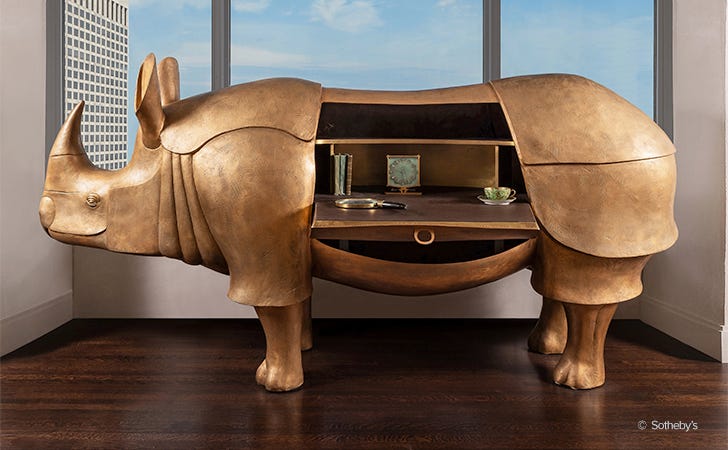
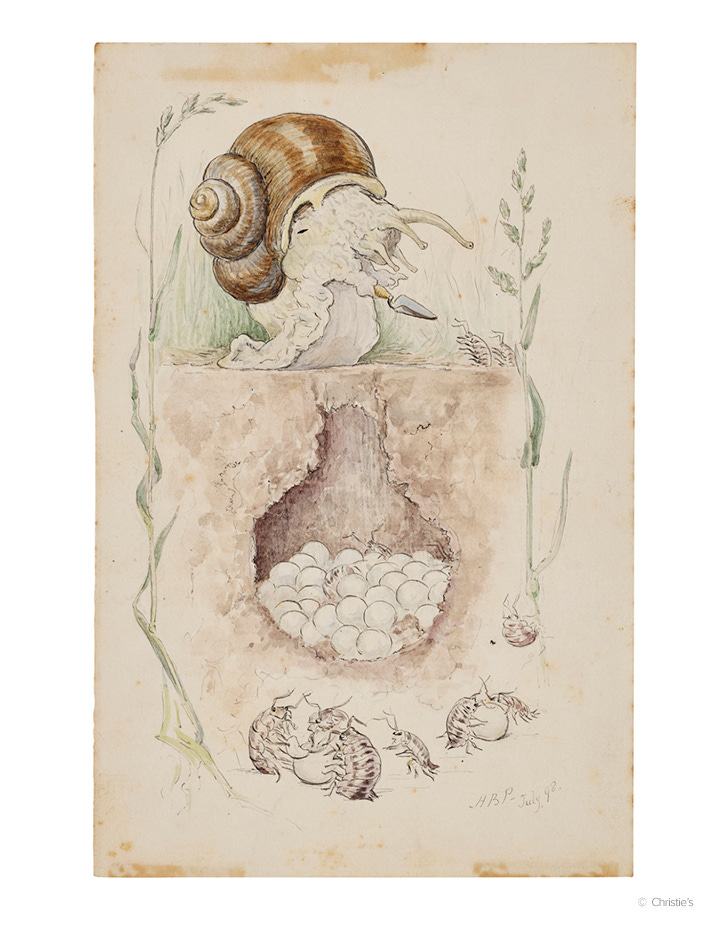
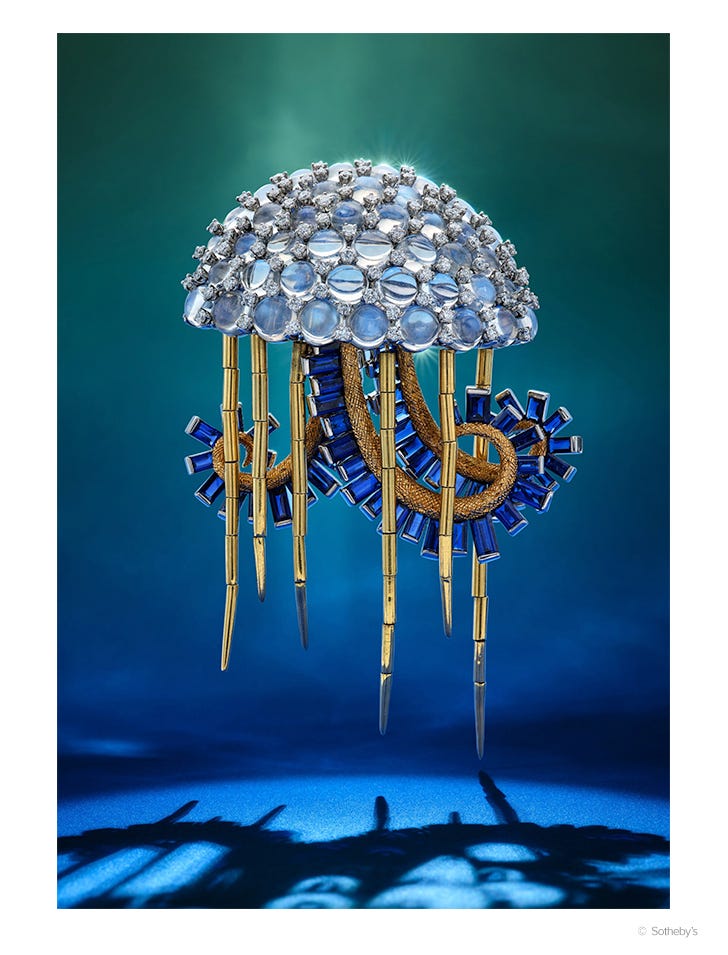

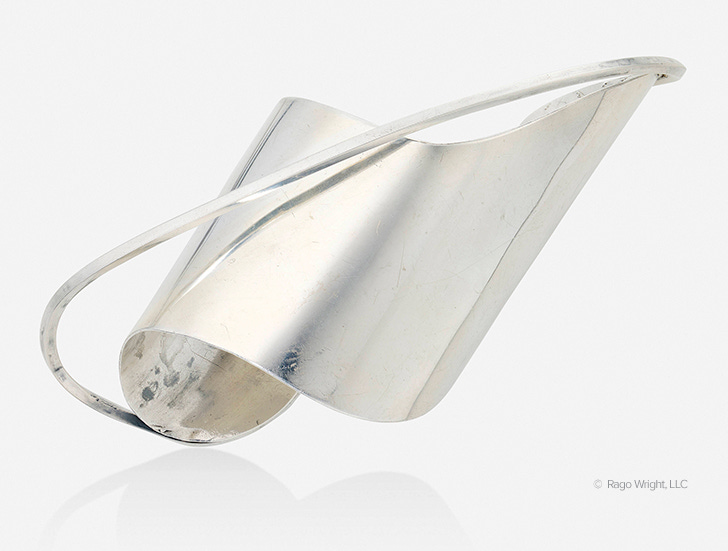

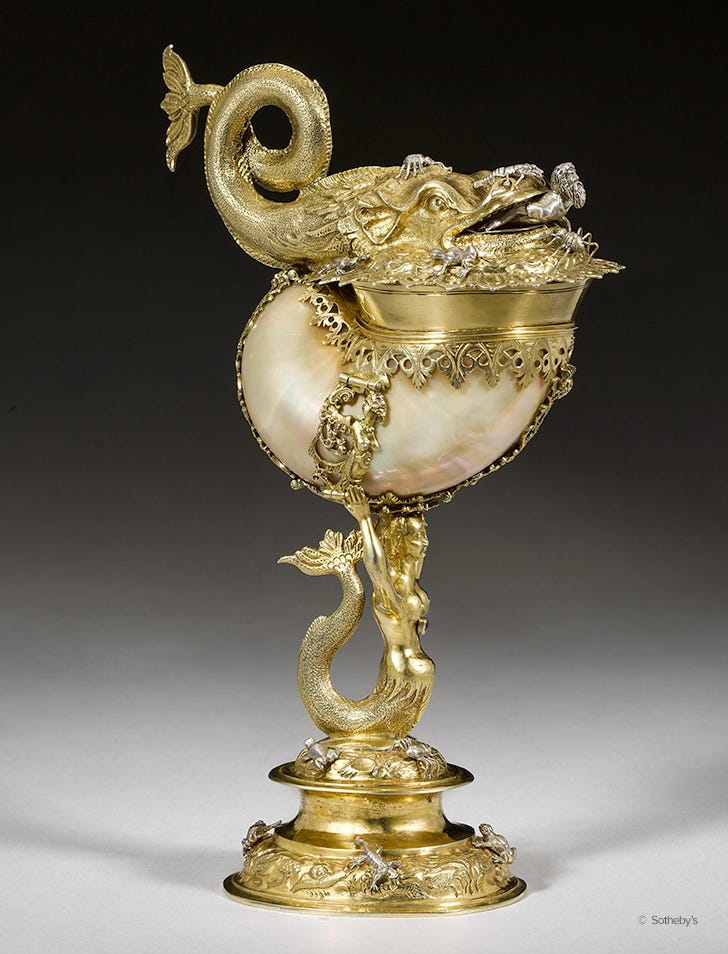

"...because it's awesome."
That about sums up the edition!
I remember seeing a knock off rhinoceros desk in a gallery in San Francisco in the early 70s. It was more like the modern one, just lifted up to show the desktop and I think it was covered in leather.
Thank you for the snail nest print! It made my day. That owl is adorable too.